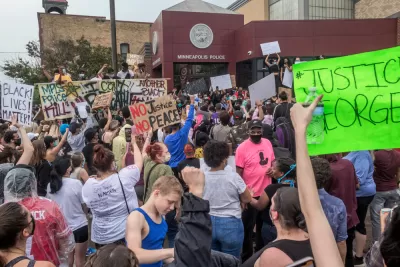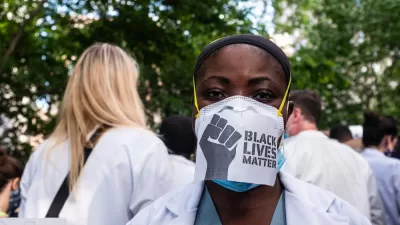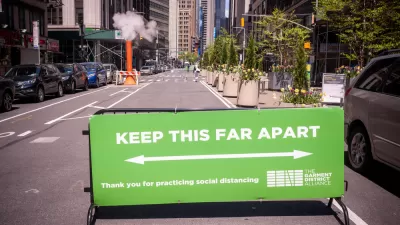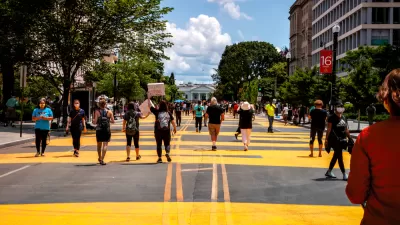After a wave violence against Black men in the United States, it is the duty of the planning profession to consider its role in perpetuating institutional racism.

[Updated with additional links on June 1, 2020.]
Overlapping crises of race and public health have created a crisis of conscience for the planning profession, in all its various forms.
White men killed George Floyd and Ahmaud Arbery. The acts were caught on video for the public to see with their own eyes. A white woman called the cops on Chris Cooper, a Black birder in New York's Central Park. The incident was also caught on video. The ensuing debate about racial justice and the neglected rights of Black Americans to exist in public without harassment and violence by white people and police has spilled over into waves of protest and late night violence from coast to coast. Suddenly the novel coronavirus, which has dominated every news cycle since early March, has been reduced to subtext.
This spasm of collective grief and anger is forcing many Americans to confront, again, the persistent force of racism in the United States. Previous moments of reckoning, repeated as recently as 2014 after a police officer killed Michael Brown and 2015 when Freddie Gray was killed in police custody, haven't brought about the systematic change necessary to overcome the challenges of racism in the United States. In 2014 and 2015, life eventually moved on. Business resumed. Nothing ever got fixed.
In 2020, planners and urbanists focused on equity are broadcasting a clear message to the wider profession that goes a step beyond connecting the racist present to its roots in the past. The message: Many of the planning innovations claimed by progressives as victories of social and environmental justice in recent years are perpetuating institutional racism.
Planning and urbanism have not achieved some apolitical or post-racial transcendence, despite good intentions. Overcoming institutional racism will require a thorough commitment to centering issues of equity in every planning discussion—from the public realm of streets and parks to the private realm of mixed-use development and housing. The slow streets and al fresco streets popping up all over the country, are subject to this critique, as explained in detail by the advocates featured in a bombshell feature by Alissa Walker, published by Curbed in May. For more sources on this subject, follow and boost the voices recommended by former Streetsblog USA editor Angie Schmitt.
Ensuring a new normal of social and racial equity will require a deep reckoning with the ways that planning innovations perpetuate systematic inequality, even among the most innovative and ostensibly progressive planning practices. It might be hard to hear, but advocates are underlining and insisting on this point, and no matter how difficult it is to confront, the field of planning is faced with an opportunity to enter a new era: one that centers racial, social, and environmental justice in every act.
For planners looking for resources to inform thoughtful action in this new era, and in addition to the numerous links to the voices of Black Americans and people of color represented by Walker and Schmitt above, we add the articles and links below to boost awareness about the fundamental issues of safety in public for people of color in the United States.
A good place to start: A blog post written last week by Tamika Butler, the former executive director of the Los Angeles Neighborhood Land Trust and former executive director of the Los Angeles County Bicycle Coalition, who is now a leading advocate for social justice in planning while working as director of planning for California at Toole Design. Butler calls for people to do more than just listen and consider the words of advocates. Butler wants to know what we are doing to make sure to ensure the safety of Black people in public:
What I want is for people to actually start being about what they say they about. It’s easy to say you care and that you understand or that you don’t understand but you want to help. But what are you actually doing? What are you doing every single day to stop the killing of black people? What are you doing every single day to make yourself think about race and racism and white supremacy and oppression and colonialism? What are you doing to make change in this revolution towards a more just society?
Butler writes there on May 27, but as the week progressed and confrontations between protestors and police in Minneapolis grew more destructive, Jennifer Toole of Toole Design released a statement on May 29 calling for planners to end silence and move beyond awareness on racism in the United States.
One of the central issues in Toole's communication is the public perception of the destructive acts that punctuated the protests in Minneapolis last week. For more writing on the destruction of property as an act of protest, see an article by Elizabeth Stoker Bruenig for Dissent magazine. For an impassioned plea to stop the looting of property in the Atlanta community, and in a tour de force of rhetoric for the cause of social justice, see also a speech delivered by rapper and Atlanta native Killer Mike.
Another distinction made by Toole is that anti-racist actions go beyond merely not being racist, and anti-racism is common theme among the advocates calling on members of the public to achieve more as allies with Black Americans during this struggle. Articles and reading lists by Ibram X. Kendi and Brea Baker will inform an understanding of anti-racist action. Former President Barack Obama on the same day of this article's publication published a list of resources for converting words into action.
Other writers, like Errin Haines and Brentin Mock have also written on the same subject, specifically referencing Chris Cooper's experience in Central Park. The Audubon Society also released a statement in the wake of that incident, acknowledging the violence and racism that Black Americans experience on a daily basis. (An article by Sarah Maslin Nir for The New York Times features an interview with Chris Cooper, who explains in his own words how he feels, and what he thinks, about the controversy that has resulted with his confrontation with the woman in Central Park.) On Twitter, Black naturalists, birders included, have a launched #BlackInNature and #BlackBirdersWeek hashtags to raise awareness and reclaim their place.
Planetizen shared the "Urban Density: Confronting the Distance Between Desire and Disparity" article by Jay Pitter as part of its ongoing tracking of the debate surrounding the role of density in spreading the coronavirus and the likelihood that the pandemic will shift public perception of development patterns. Pitter's article, however, deserves much more specific attention for its eloquent and erudite examination of one of the remaining fissures between urban planning and equity. Pitter distinguishes between forms of density, "dominant density" and "forgotten density," to expand the density discourse, makes clear the terms necessary for centering health equity in urban development, and provides real world examples of planning efforts that have done an effective job in achieving those goals. Specific examples of equity-building development processes cited by Pitter include the Anti-Displacement Policy Toolkit by the Association for Neighborhood and Housing Development in New York, the Washington, D.C. 11th Street Bridge Park, and Residential Apartment Commercial (RAC) Zoning in Toronto.
Another article by Julian Agyeman, professor of Urban and Environmental Policy and Planning at Tufts University, shifts the focus of the barriers to equitable planning practice to the realm of transportation, with a discussion about the "invisible cyclists"—people of color who advocate for bike infrastructure but are often neglected by the implementation of bike plans. The result has led to bike lanes characterized as "white lanes" and harbingers of gentrification. Another point raised by Agyeman is the disparities in policing of people of color on bikes, which must be addressed before bike infrastructure can be considered something other the site and location of oppression and inequality.
Ibram X. Xendi also wrote recently about the risks facing Black people in public, as exemplified by the killing of Ahmaud Arbery.
For more discussion of what it would mean for planning to center equity, a Twitter thread by Transportation Alternatives provides a clear description of the intersection of social justice and planning innovation, and a calls for planners to implement this understanding into practice.
The American Planning Association (APA) over the weekend released a statement on the killing of George Floyd.
The impact of Mr. Floyd's death and other recent grave injustices like it must be viewed in light of the historical trauma inflicted on African American communities, including discrimination wrought by the planning profession itself, which led to structural disadvantages in housing, transportation, education and employment that last to this day.
The statement also serves to offer a few resources already generated by the organization to help planners with the work of centering equity in professional planning practice, including the Planning for Equity Policy Guide, the AICP Code of Ethics, and the new online public engagement toolkit.
The country has been dealing with an unprecedented anxiety and completely unexpected trauma for months now, and clearly many people in this country want to get back to normal. With so much energy and thought devoted to helping the country recover from the pandemic, many advocates, including former President Barack Obama, are calling for a recovery that doesn't allow the kind of "normalcy" that allows racial violence to persist. There will be solidarity in this change: on this very day, advocates in the realm of climate change education and action are making similar connections between environmental causes and racial and social justice.
In recent years, the planning profession has made major strides in making a public account of its historical track record of racial and environmental mistakes, bridging generations and with consequences lasting into the present. But it's clear that reckonings with the past have failed to change the structures of institutional racism in the present or into the future. Planners, most inspired to the career by idealism and a desire to help, must be among the first Americans to decide and act on a new normal.

Maui's Vacation Rental Debate Turns Ugly
Verbal attacks, misinformation campaigns and fistfights plague a high-stakes debate to convert thousands of vacation rentals into long-term housing.

Planetizen Federal Action Tracker
A weekly monitor of how Trump’s orders and actions are impacting planners and planning in America.

In Urban Planning, AI Prompting Could be the New Design Thinking
Creativity has long been key to great urban design. What if we see AI as our new creative partner?

Portland Raises Parking Fees to Pay for Street Maintenance
The city is struggling to bridge a massive budget gap at the Bureau of Transportation, which largely depleted its reserves during the Civd-19 pandemic.

Spokane Mayor Introduces Housing Reforms Package
Mayor Lisa Brown’s proposals include deferring or waiving some development fees to encourage more affordable housing development.

Houston Mayor Kills Another Bike Lane
The mayor rejected a proposed bike lane in the Montrose district in keeping with his pledge to maintain car lanes.
Urban Design for Planners 1: Software Tools
This six-course series explores essential urban design concepts using open source software and equips planners with the tools they need to participate fully in the urban design process.
Planning for Universal Design
Learn the tools for implementing Universal Design in planning regulations.
Gallatin County Department of Planning & Community Development
Heyer Gruel & Associates PA
JM Goldson LLC
City of Camden Redevelopment Agency
City of Astoria
Transportation Research & Education Center (TREC) at Portland State University
Jefferson Parish Government
Camden Redevelopment Agency
City of Claremont






























